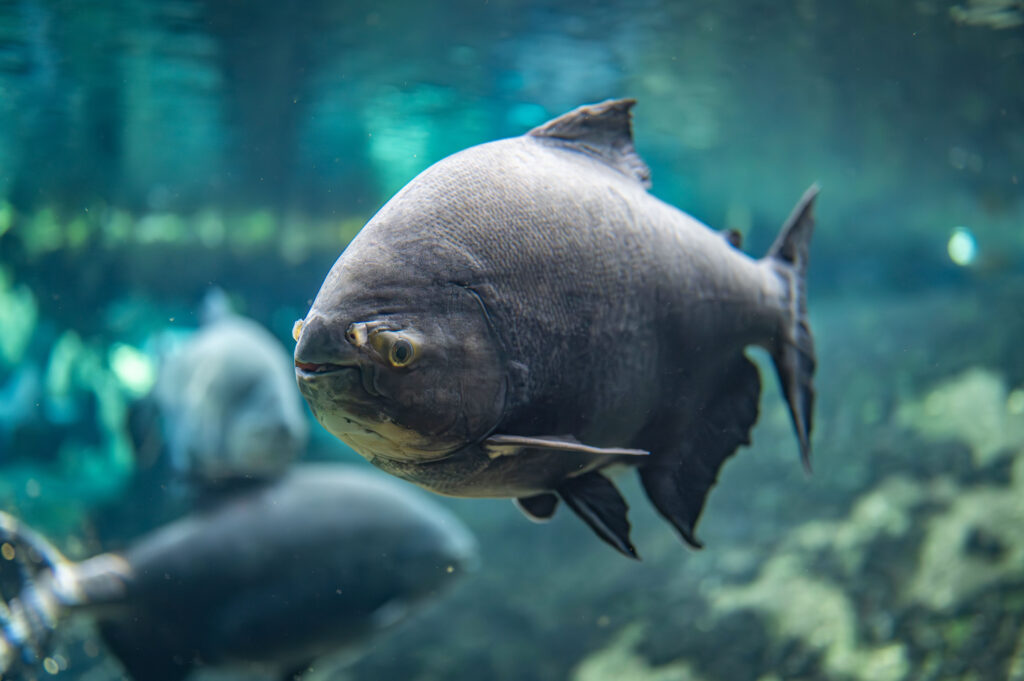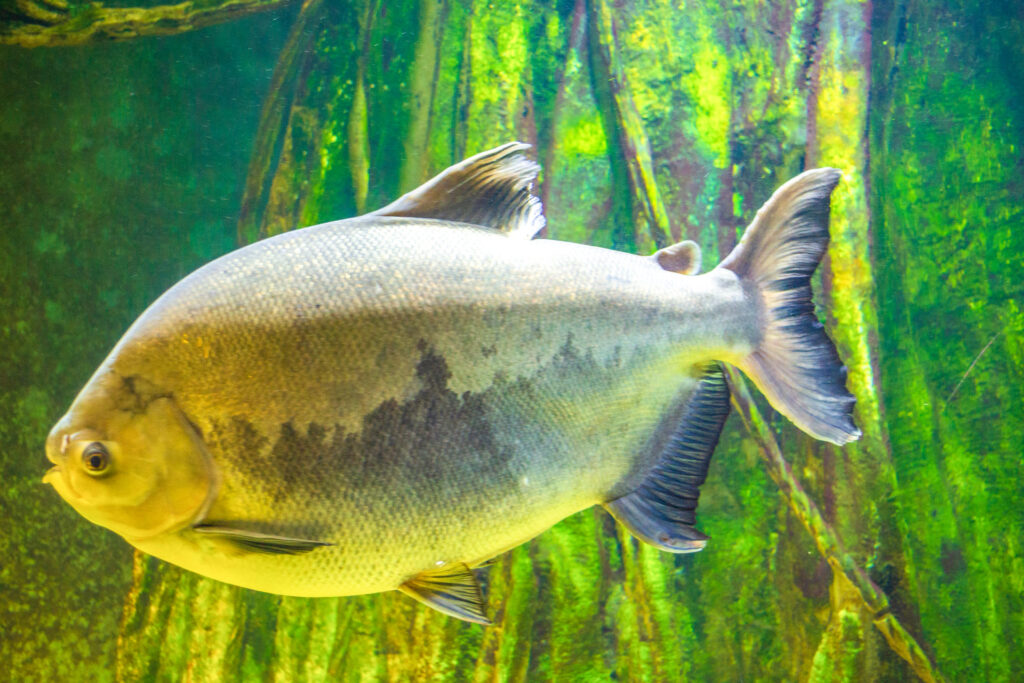If you have ever looked into the waters of South America’s rivers, you might have come across a curious fish with teeth that look remarkably human. This is the pacu fish, a species often mistaken for the notorious piranha. While they share a family tree and a similar shape, the two are actually very different in their behaviour, diet and role in the ecosystem.
In this guide, we will explore what a pacu fish is, how many types exist, the differences between pacu and piranhas, fascinating facts about their biology and, importantly, how you can see them up close at Bristol Aquarium.
What is a pacu fish?
The name pacu fish refers to several species of freshwater fish native to South America. They belong to the Serrasalmidae family within the Characiformes order, a large group of freshwater fish found across the continent. Pacu are close relatives of piranhas, yet their lifestyle and characteristics make them very different.
Known for their distinctive teeth, which look like human teeth, pacu fish are perfectly adapted for crushing seeds and fruit that fall into rivers. This funny quirk has fuelled their reputation as one of the most intriguing freshwater fish in the Amazon Basin.
How many species of pacu fish are there?
Pacu covers 9 recognised fish species. The two most familiar are the black pacu (Colossoma macropomum), sometimes called the giant pacu, and the red pacu (Piaractus brachypomus). Both are commonly kept in aquariums around the world and are adored for their mighty attitude.

What’s the difference between a pacu and a piranha?
Although pacu fish and piranhas belong to the same family, they could not be more different in their appearance and habits.
The most obvious distinction lies in their teeth. pacu fish have flat, human-like teeth designed for grinding and crushing plant material, whereas piranhas have razor-sharp teeth that are built for tearing meat. This difference in their teeth reflects their diets: pacu are primarily omnivorous, feeding on plants, seeds and fruit, while piranhas are mostly carnivorous.
In terms of behaviour, pacu are calm and peaceful fish, whereas piranhas are known for their more aggressive tendencies. Even their size sets them apart, with pacu often growing far larger than piranhas.
Fascinating facts about pacu fish
Pacu fish are not only distinctive in appearance but also play an important role in their environment. Here are some of the most remarkable things you should know about pacu.
Pacu fish never stop growing
One of the most astonishing features of pacu fish is their continuous growth. Some pacu fish have been recorded at over a metre in length and weighing up to 40kg. Their final size depends on a combination of genetics and environmental conditions, which is why they thrive in the huge river systems of South America.
Pacu play an important role in river ecosystems
By eating fruit and seeds, pacu fish act as dispersers of plant life. When they feed, they transport seeds across wide areas, helping maintain the biodiversity of the Amazon Basin.
Pacu fish are native to the Amazon Basin
These fish are found in South American rivers that flow across Brazil, Peru, Colombia and other countries. Their distribution shows just how adaptable they are, able to survive in a variety of freshwater habitats, from slow-moving floodplains to deeper channels.
Pacu fish have inverted camouflage
The black pacu displays an unusual colouration pattern known as inverted camouflage. Instead of being darker on top and lighter beneath, as is common in aquatic species, they are darker underneath and paler on the back. This unique trait sets them apart visually from lots of other fish.
Pacu fish have multiple fins
The body of a pacu is sturdy and plate-shaped, quite different from the streamlined shape of fast predators. Their dorsal fin provides stability and helps them make sharp manoeuvres, while the caudal fin powers them through the water. Anal, pelvic and pectoral fins further enhance their control, allowing them to navigate dense aquatic vegetation with ease.
Pacu fish can live for decades
In the right conditions, the pacu fish’s lifespan can last over 40 years. This longevity makes them one of the longest-living freshwater species in captivity, provided they are given the right diet and space.

See pacu fish at Bristol Aquarium
If you would like to see these remarkable fish in person, Bristol Aquarium is home to two species: the black pacu and the red pacu.
The black pacu is the largest of the pacu family, with its heavyset body and distinctive inverted camouflage making it easy to identify. The red pacu is smaller but equally eye-catching, with bright red colouration on its belly. Both species at Bristol Aquarium have been rehomed or rescued, meaning that when you see them, you are meeting fish with personal histories as well as fascinating natural traits.
You can find them both in the Amazing Amazon exhibit, where the sights and sounds of the rainforest bring their South American habitat to life.
Plan your visit
To discover pacu fish and many more remarkable creatures of the aquatic world, plan your visit to Bristol Aquarium bookings. You can learn more about them at our daily Amazing Amazon talk. Discover all our feeds on our talks and feeds schedule.
